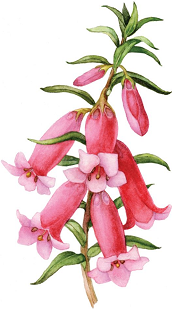Protect Your Plants from Frost Damage
Frost damages many plants and may even kill them, therefore steps to minimise damage need to be a consideration for every garden or plantation.
Most of Victoria is liable to frost at some time of the year. Areas along the Great Divide and the adjacent slopes are amongst the most frost-prone parts of Australia.
Local knowledge is important in planning for frost because features of the landscape such as valleys and hills can channel or divert cold air as it flows downhill, creating microclimates which are significantly more or less frost-prone than the surrounding region.
Frost Facts
♦ Frost damage occurs when plant tissue is frozen. Freezing causes the plant’s cells to shrink, forcing water into spaces between the cells where it can freeze and form ice crystals. As temperatures rise and thawing begins the water is absorbed back into the cells by osmosis. If this occurs quickly there is no damage to the tissue, but if thawing is slow, the cells are deprived of water and become dehydrated resulting in ‘frost burn’.
♦ Frost damage can also occur in times of rapid thawing when frozen foliage receives strong sunshine.
♦ Frequent low night temperatures in autumn help to harden stems and foliage, reducing the likelihood of frost damage.
♦ Severe frost damage is more likely to occur in late winter and spring when new foliage is appearing:
♦ Light frost: down to about -2 to -3°C. Foliar damage may occur on some plants.
♦ Moderate frost: down to about -4 to -5°C. The next major damage point.
♦ Heavy frost: beyond about -6°C. The next group of plants susceptible to cold damage is affected.
How to Minimise Frost Damage
Cultivate frost-tolerant plants
This is an aspect of gardening that is difficult to adhere to. Gardeners may not want to understand or believe that some of the plants in their garden are not suitable for the local climate. They are mesmerised by some attribute of foliage, flower, or form which makes a plant a ‘must have’, and become oblivious to the pressure it will be put under by low temperatures.
>> Select a Frost-tolerant Plant from our list of recommended plants.
Take advantage of microclimates
The number of microclimates even on a suburban property can be surprising. Well-developed tree canopies can be valuable for affording frost-protection. Observe which areas on the property are free of frost pockets. This is where tender plants should be grown.
No nitrogenous fertilisers after midsummer
In frost-prone areas it is recommended that nitrogenous fertilisers should not be applied to plants after midsummer because they promote foliar growth.
Avoid blocking air flow
Organise plantings so that they do not block the flow of cold air at or near ground level, because wherever airflow is curtailed is where the greatest area of frost will occur. Avoid anything that may form an ‘air dam’, such as a build-up of weeds around plants, hedges, fences, buildings, etc.
Keep soils moist
Dryness is an ally of frost.
Mulch with gravel or screenings
Avoid organic mulches because they have plenty of spaces to act as ‘air dams’ where frost can occur.
Avoid recently cultivated soil near plants
Recently cultivated soil contributes to frost damage as there are many nooks, crannies, and depressions where cold air can be trapped. This aspect is understood by orchardists and viticulturalists who, in late winter and early spring, roll the soil flat in close proximity to their trees and vines.
No winter / spring pruning
Do not prune in winter or spring until frosts are thought to be finished for the season. As sap flow increases and young leaves begin to burst forth this is a perfect time for frost damage to occur.
Overhead protection
Provide overhead protection, using hessian, to help retain radiant heat near the plants. Do not cover plants with plastic bags as they do not always exclude frost, and can exacerbate damage if hit by strong sunlight early in the day after a frosty night.
Spray with seaweed products
Spray applications of seaweed products help to strengthen cell walls, minimising the chance of frost damage and also helping the plant cope with excessive heat.
Based on an article by Rodger Elliot
